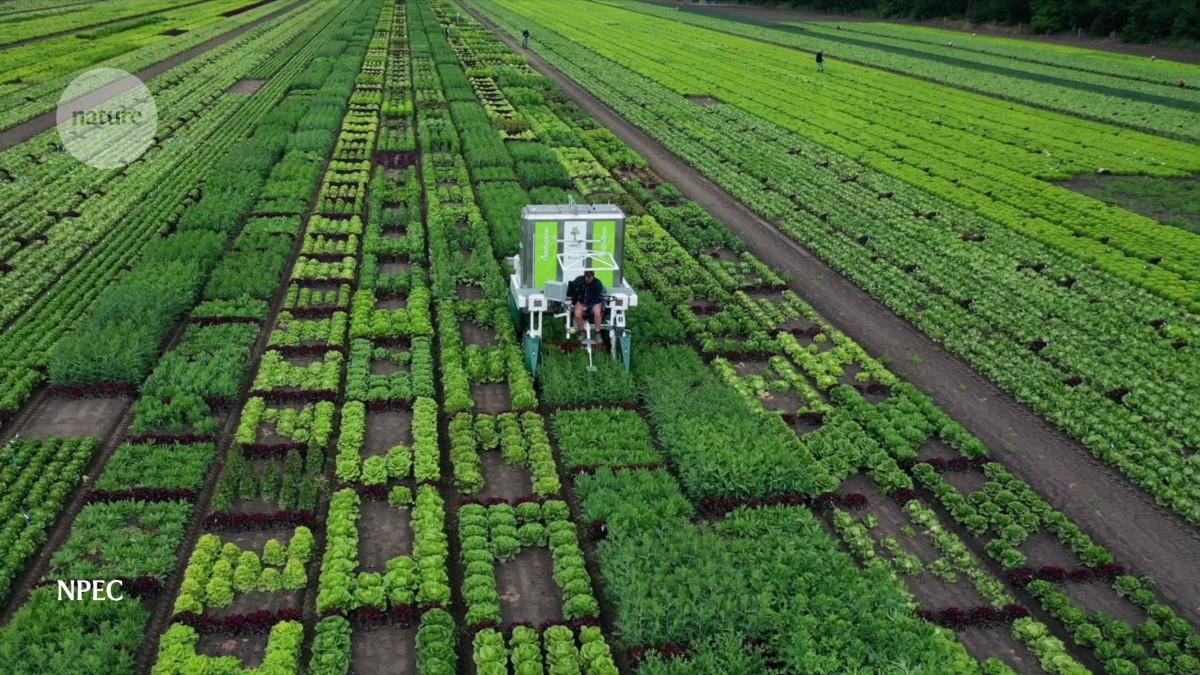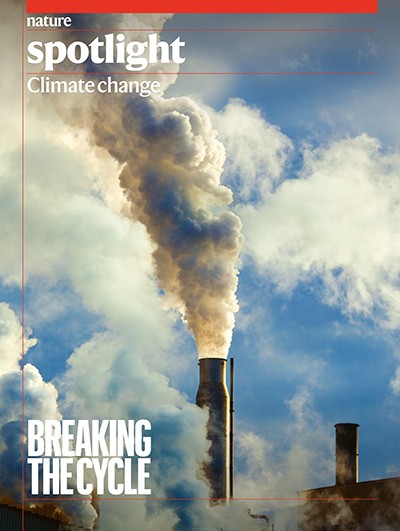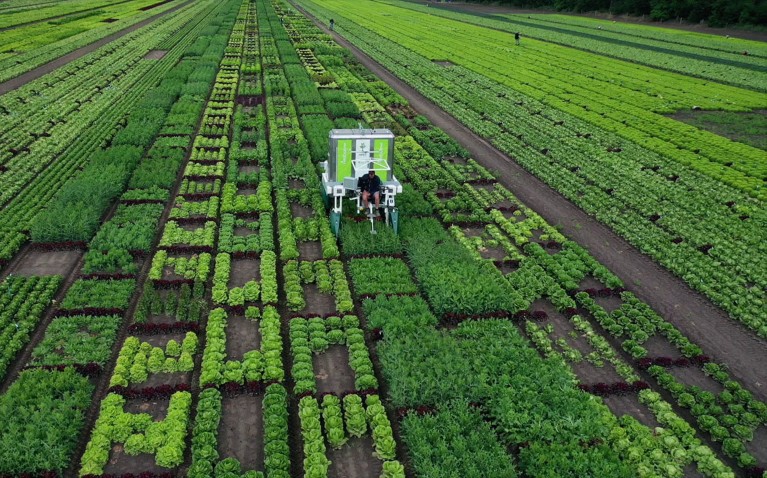
A mobile plant-phenotyping device screens lettuce varieties in the Netherlands.Credit: The Netherlands Plant Eco-phenotyping Centre
Humans’ collective prospects as a species don’t look great. By 2050, the global population will hit an estimated 9.7 billion, meaning there will be 1.5 billion more mouths to feed than today. Demand for animal-derived protein, with its high environmental price tag, is predicted to rise faster still. Global temperatures and atmospheric greenhouse-gas concentrations are still increasing, tree cover is shrinking, oceans are acidifying, agricultural land is being lost to salinization, and extreme weather events are becoming more frequent.
Nature Spotlight: Climate change
But where some see threats, others see opportunities. In May, researchers and small businesses with a range of ideas for producing food more sustainably gathered at F&A Next, a meeting on the future of food and agriculture held at Wageningen University & Research in the Netherlands. From climate-smart cultivation to breakthrough protein alternatives, a wave of innovations were revealed at the event.
Globally, protein demand is projected to grow more rapidly than the population, because of rising incomes, urbanization and changing dietary preferences. Farming animals for food contributes to deforestation, biodiversity loss and around 57% of the global greenhouse-gas emissions associated with food production1. As a result, many researchers think that the only way forward is to shift to alternative protein sources.
Some popular plant-based proteins come with their own environmental issues. Soya-bean production, in particular, has been linked to deforestation, biodiversity loss and increased greenhouse-gas emissions, leading researchers and entrepreneurs to investigate alternatives.
Green, green grass
Grassa, a start-up company based in Wageningen, is developing grass-based protein extracts for inclusion in pet food, livestock feed and, ultimately, products for human consumption, such as burgers, snack bars and dairy-free milk. “Compared to soy, grass protein has a better amino-acid profile, comparable digestibility, a lower carbon footprint and, once scaled up, can be priced competitively,” Rieks Smook, the firm’s chief executive, told the meeting.
At Grassa, freshly cut grass is fed into an extruder, producing a liquid that is then heated and filtered to denature the proteins. These coagulate into a green paste containing half of the grass’s protein. Organic solvents remove fats and chlorophyll from this paste, and membrane filtration removes sugars and minerals, leaving a neutral-tasting, off-white powder that is around 70% protein.
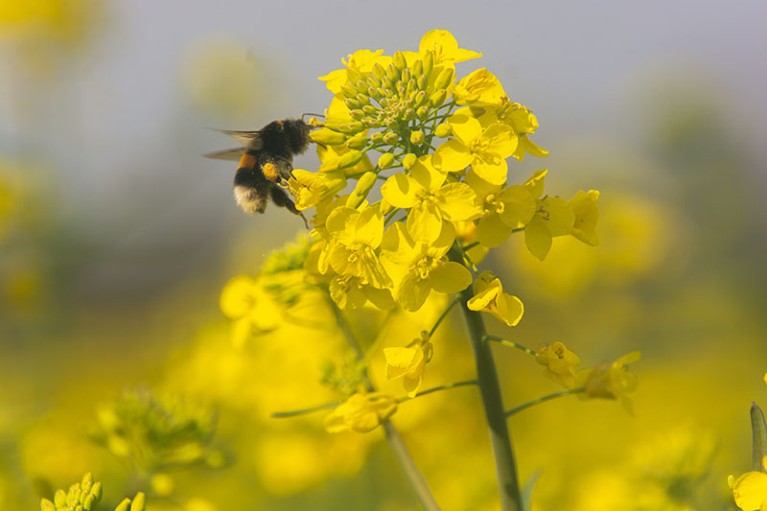
A bee collects pollen from the flower in a rapeseed field.Credit: Ying Tang/NurPhoto via Getty
Crushed grass is also left over from the extrusion process. According to Grassa, cows that are given a 50:50 mix of this by-product and their standard feed produce milk with a similar nutritional profile to that from animals on a normal diet. However, their manure contains less nitrogen — potentially reducing the run-off of polluting nutrients into waterways.
Smook says that the carbon dioxide footprint of grass protein is significantly lower than that of imported soya, according to a life-cycle assessment by the company. Starting next year, Grassa is planning a two-year demonstration project involving 50 farmers, and is aiming to open a full-scale production plant in 2028, initially producing protein for pet food. The company wants to launch a grass-protein extract for human consumption by 2029, but will need the approval of the European Food Safety Authority to market it as a food ingredient in the European Union.
Fermented future
Humans have used fermentation to preserve and transform foods for thousands of years, but now a new generation of start-up firms is using precision fermentation to make proteins with the same functional and nutritional properties as those produced by farm animals. “To a certain extent, we consider ourselves farmers,” Stephan van Sint Fiet, chief executive of Vivici, based in Leiden, the Netherlands, told the meeting. “We use crops from the land and then we make milk proteins — but our ‘animals’ are just a little bit smaller.”
Vivici uses yeast that has been genetically modified to produce β-lactoglobulin (BLG), a whey protein found in cow’s milk that is prized for its functional properties, including gelling, binding, emulsification, solubility and ability to form foams. The yeast-made BLG is an ingredient in protein drinks and snacks, and Vivici is planning to launch another product based on lactoferrin, a protein found in the milk of humans and other mammals that supports the functioning of the immune system.
But there are questions over whether it is commercially viable to produce dairy proteins through precision fermentation. One estimate of the cost of scaling up such production for large-scale commercial applications puts the price tag at US$100 million at least2, depending on the volumes involved. Vivici says it is working on ways to bring costs down and that it is confident it can reach price parity with dairy-based equivalents.
If production can be scaled up economically, fermentation-derived protein could have environmental benefits. Researchers at the Potsdam Institute for Climate Impact Research in Germany estimate that replacing 20% of the protein consumed in the form of meat from ruminants, such as cattle and sheep, with microbial protein by 2050 could halve deforestation and related CO2 emissions, while also lowering methane emissions3.
Probiotics for plants
Beyond alternative sources of protein, another way to feed Earth’s growing population sustainably is to increase crop yields, leading to lower carbon emissions by reducing the need to clear forests for agriculture. This approach has merit even when cultivation is soilless, or hydroponic.
The market for ‘controlled-environment agriculture’ — which includes the production of crops in hydroponic greenhouse systems — was valued at nearly $100 billion in 2024. But, just as the microorganisms in the human gut influence health, plants have evolved to rely on bacteria and fungi in soil to thrive, using these microbes to maximize nutrient uptake and build disease resistance. This means that the crops in soilless systems develop without the support of their natural microbial partners. “There’s an enormous amount of untapped potential to improve the growth, taste and disease resistance of these crops by putting those microbes back in,” said Paul Rutten, founder and chief executive of London-based start-up Concert Bio, at F&A Next.
In 2022, Rutten, who has a PhD in plant–microbe interactions from the University of Oxford, UK, began a three-year project with growers to identify the microbiomes of crops using DNA sequencing, as well as recording their growing conditions and yields. Using a machine-learning model, he highlighted correlations between the presence of specific microbes and higher yields in conditions of varying temperature, sunlight and humidity, for example.
Last November, Concert Bio launched Overture A and B, two ‘biostimulant’ bacterial products made through fermentation, on the UK market for use in soilless agriculture. Rutten says that across 14 trials, lettuce growers achieved yield increases of 9.9%, on average. Trials of several candidate probiotics for tomatoes and cucumbers are under way.
Bring on the bees
Another way to reduce the carbon footprint of agriculture is to address insufficient pollination. Insect pollinators are crucial for the successful production of three-quarters of crop varieties. In 2022, researchers at Harvard University in Cambridge, Massachusetts, estimated that pollinator deficits reduce global yields of fruit, vegetables and nuts by 3–5%4.
AgriSound, a start-up firm based in York, UK, has developed a mobile-phone-sized device that can detect low bee numbers in fields and greenhouses on the basis of the sound of their wingbeats, enabling growers to bring in more bees when needed. The technology uses artificial intelligence (AI) to detect the combinations of frequencies made by honeybees and bumblebees, and to cancel out noise (although this does not work in noisy environments, such as near major roads).
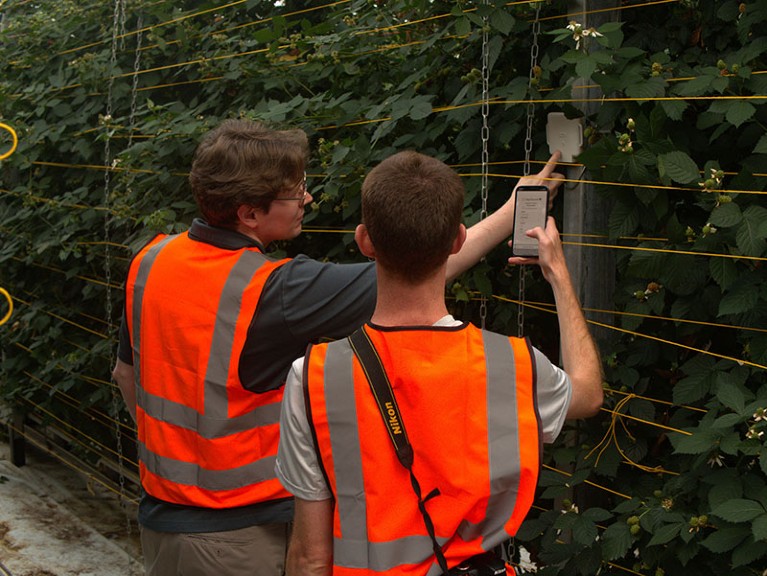
The AgriSound system uses artificial intelligence to identify the sound of honeybees’ and bumblebees’ wingbeats, and thereby determine bee numbers.Credit: Robin Wilson
Casey Woodward, AgriSound’s founder, took inspiration from the acoustic systems already used to identify respiratory disease on pig farms and injurious pecking in poultry farms. Woodward told F&A Next attendees that, in trials at sites where the AgriSound system identified low bee numbers, strawberry growers increased the fruit’s weight by 8.5%, sweetness by 5% and the proportion of high-quality produce by 10% by introducing extra bees, when compared with neighbouring control locations where bee numbers were left low.
“We also have evidence to show that precision pollination can extend the shelf life of strawberries by about 12 hours, which reduces waste and carbon emissions as a result,” Woodward added. The company is seeking to adapt its technology to identify other pollinators and pests.


